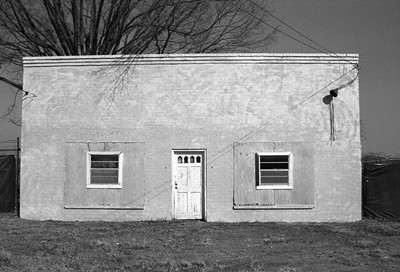
I think that not ending City of Dust with the last (soon-to-come) post from the CSRA is a good idea. However, it sort of wrecks my whole concept. See, after exhausting all my Augusta-area info, I had planned on just stopping, unannounced. No fanfare, no farewell, nothing. Then I was going to cast the site adrift to sail, unmanned and abandoned, through the far reaches of cyberspace for all eternity. I could even pay my server fees in perpetuity from an anonymous bank account or something. It just seemed so fitting. Now I find that abandonment isn't always so easily. Actually, I was going to make one change to the site before I let it go, and subtly change the name in the banner. What to? "The Flying Dustman," of course. Oh well, it was a nice concept. We're down on Sand Bar Ferry Rd. now, in what's known as The Bottoms. The front of this building is actually a facade; the building itself is a good bit smaller. Also, it's not abandoned.
The Metro Spirit, Augusta's weekly newspaper, had a cover story on The Bottoms a few weeks ago. Had I been smart, I would've copied the article and used some of the historical info here. The best parts were the quotes from long-time residents. But, alas, the Spirit only posts the current issue on their website, and so I'm on my own. Actually, there's not that much left to say.
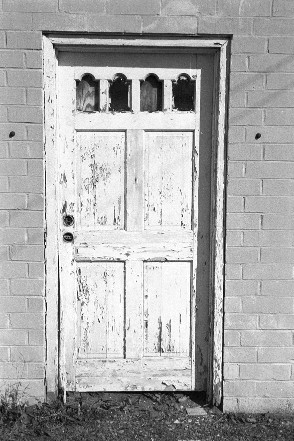 I've already mentioned that the original site of the Sand Bar Ferry, on the river, used to be a popular dueling ground. We know that Charles Tilly, the last person to be killed in a duel in Georgia, was shot there. In keeping with this history, The Bottoms have long been known as a dangerous place to live. The Spirit article mentioned the violence, and noted that at one time there was a running feud between rival housing complexes. Incidentally, "The Bottoms" is short for "River Bottoms," and, historically, this area was very prone to finding itself under a good deal of water. The levee that runs through Augusta was built in 1911, and is just feet away from these photos. Still, floods were a big problem here until the Thurmond Dam was built in 1954.
I've already mentioned that the original site of the Sand Bar Ferry, on the river, used to be a popular dueling ground. We know that Charles Tilly, the last person to be killed in a duel in Georgia, was shot there. In keeping with this history, The Bottoms have long been known as a dangerous place to live. The Spirit article mentioned the violence, and noted that at one time there was a running feud between rival housing complexes. Incidentally, "The Bottoms" is short for "River Bottoms," and, historically, this area was very prone to finding itself under a good deal of water. The levee that runs through Augusta was built in 1911, and is just feet away from these photos. Still, floods were a big problem here until the Thurmond Dam was built in 1954. 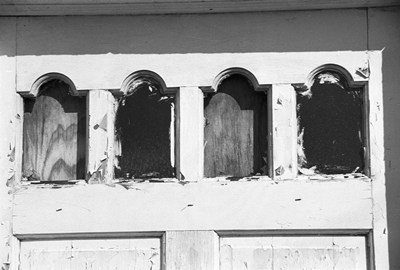
Much of Sand Bar Ferry Rd. is pretty industrial. There are welding shops and auto salvage yards. Also, the area is a haven for stray dogs. Dogs are always showing up dead on the side of the road, but then more arrive to quickly take the place of the deceased. Where are they coming from? I speculate that the dogs on Sand Bar Ferry migrate over from Laney-Walker, where things are even tougher. The dogs on Sand Bar Ferry Rd. may have matted fur and drag bits of rope behind them, but the dogs on Laney-Walker are missing legs and have hunks of chain swinging from their necks.
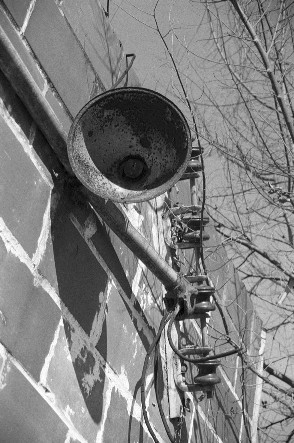 But the Metro Spirit article pointed out that things are improving. Residents were quick to mention this, as well. There are a few churches, a couple convenience stores, a record store (The Dirty Souff), and a beauty parlor, which keep things active. Also, folks from the welding and repair shops are usually outside, talking to customers and passersby, and this street life helps any neighborhood. Although there are a number of residential homes along the road, on the Saturday morning I took these photos there was not a soul around. It would sure be nice if they could find a tenant for the Goodale Inn, which is farther down. I've posted plenty of photos of the Goodale Inn before, and even put up a shot of the weird billboard/movie screen that's adjacent awhile back. This is a light fixture from the very-abandoned vet clinic, which is next door to a not-so-inhabited bar.
But the Metro Spirit article pointed out that things are improving. Residents were quick to mention this, as well. There are a few churches, a couple convenience stores, a record store (The Dirty Souff), and a beauty parlor, which keep things active. Also, folks from the welding and repair shops are usually outside, talking to customers and passersby, and this street life helps any neighborhood. Although there are a number of residential homes along the road, on the Saturday morning I took these photos there was not a soul around. It would sure be nice if they could find a tenant for the Goodale Inn, which is farther down. I've posted plenty of photos of the Goodale Inn before, and even put up a shot of the weird billboard/movie screen that's adjacent awhile back. This is a light fixture from the very-abandoned vet clinic, which is next door to a not-so-inhabited bar. 
Everyday I used to get on the John C. Calhoun Expressway... Well, yes, the JCC expressway IS completely across town from The Bottoms and, so, YES, once again, these photos and what I'm about to tell you have absolutely no relation. But, I'll tell this anyway. See, in Minneapolis, I used to live very close to Lake Calhoun. Only recently did I find out that the expressway and the lake were named for the same guy, a South Carolina-born, Yale-educated, former-vice president. I never got into the little house on Reynolds St., shown above, due to the huge amount of broken glass on the floor and the spiky bits of metal and wood sticking out from every surface. See: garbage houses.
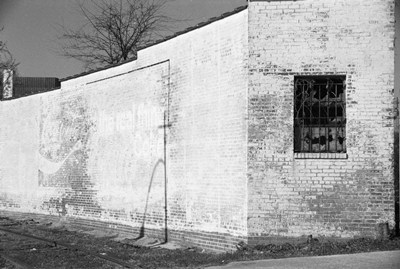
Right, so, John Caldwell Calhoun was born in 1782 in Mt. Carmel, SC, approximately 48.1 miles from Augusta. He served in the SC state legislature and did three terms in the US House of Representatives. As the war of 1812 loomed, John C. and Henry Clay, two "warhawks" who felt the US was wallowing in a "putrescent pool of ignominious peace," were instrumental in finally getting war declared on England. Remember, rumor had it that Henry C. hung out at Getzen's Pond. Anyway, Calhoun was Secretary of War under James Monroe from 1817-1825. Ah, yes, remember when they just came right out and called the guy the Secretary of War? I believe this Coca-Cola bottling plant on Reynold St. is still operational. Why couldn't I just find out for sure? I don't know.
Calhoun ran for president in 1824, but eventually withdrew from the race. Instead, he ran unopposed for vice president. Ah, yes, remember when we voted for vp? Well, no, me either. Anyway, John Quincy Adams became president in 1824, and Calhoun was re-elected veep for Andrew Jackson's term in 1828. However, Jackson was in favor of the Tariff of 1928, which had been proposed by New Englanders who felt Britain was dumping cheap textiles onto the market. Calhoun saw the tariff as beneficial only to the industrial North, while hurting the South, which needed to sell cotton to English firms. So, Calhoun, now openly hostile to Jackson, became the only vice president in history to resign. He also wrote "The South Carolina Exposition and Protest," which essentially asserted that all federal laws should be nullified. His views earned him the nickname "Arch Nullifier." Ouch, that must've hurt. In 1832, the SC legislature agreed with Calhoun, and Jackson threatened to send in the army. Henry Clay stepped in to settle the dispute. A year later, Calhoun and Daniel Webster had a legendary debate in which Calhoun vehemently argued for states' rights and slavery. We took a quick turn off Reynolds and popped back down to Ellis St. AGAIN, this time on the east end of downtown.
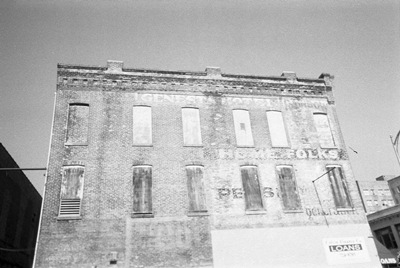
Calhoun was appointed Secretary of State by President John Tyler in 1844. Bet you didn't even know a guy named John Tyler had been president, eh? Calhoun later went back to the Senate, where he was strongly in favor of annexing Texas and against the Wilmot Proviso, which stated that any territory obtained during the Mexican War should be free from slavery. Calhoun died in 1850 and was buried in Charleston. In 1957, despite his views (or because of them?), the US Senate honored Calhoun as one of the five greatest Senators of all time. Now, I suppose it's not so odd that Georgia named a rather short expressway after Calhoun. He was, after all, from nearby. But the real question is: Why would he be the namesake of one of the most popular lakes in Minneapolis, Minnesota? We've seen this bridge before. It leads over the Savannah River, into the ghost town of Hamburg, and on to the next post.

3 comments:
Fantastic blog. Sorry to see that you'll be ending soon, but good luck on future endeavors. Feel free to abandon the abandonment and keep posting. That would probably be most fitting.
BD
I'm also sorry to hear this and hope you'll reconsider. I'll be up in your neck of the woods (or at lease closer than I am now) soon on a trip to Mistletoe State Park near Appling, Georgia.
Hey, John, I hope also you can find more to print - should I still try to send you a CD full of the pics I took?
And, to the John above, don't expect to ride your bike in Mistletoe! J Mulhouse and I went there one summer day and almost died between the heat, spider webs and the fact that the lake it 6 feet higher than when they laid out the trails (couple of stream crossings way under water).
Chris xt235
Post a Comment